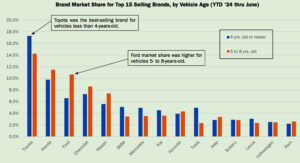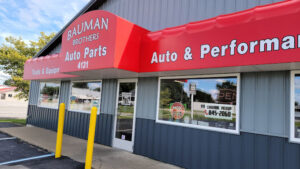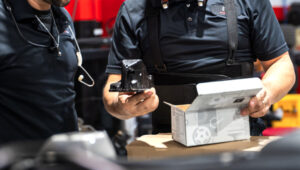The new Congress will have national Right to Repair legislation reintroduced and the aftermarket industry is hopeful that now is the time to get it passed
Las Vegas—It’s an interesting time to be an aftermarket supplier. Many of which are now living in an increasingly tug-and-pull industry, as present day aftermarket business models are juggled and juxtaposed with new and developing vehicle technologies that present new opportunities for growth and profit. And challenges.
“It’s the ‘innovator’s dilemma,’” explained Paul McCarthy, Automotive Aftermarket Suppliers Association (AASA) president and CEO, at a media briefing during AAPEX last month in Las Vegas.
The dilemma is the challenge of managing two businesses at the same time: one, maximizing the returns from an existing business in the aftermarket, which has a long, profitable tail; and, two, in parallel, growing new innovative business, preparing to take advantage of aftermarket opportunities of electrified, connected and automated vehicles.
“Assuming we are able to successfully defend against our [OEM] competition with Right to Repair legislation, the aftermarket is very well positioned to thrive in both the present and the new industries — and to manage what will be a decade-long evolution of profitability.”
One opportunity of note for a developing and growing technology that the aftermarket can capitalize on: Advanced Driver Assist Systems (ADAS).
“There has been so much focus on vehicle electrification,” said McCarthy, “that it’s sucked all the oxygen out of the room and we’ve forgotten about a revolution that’s happening right now — which is ADAS.”

AASA members released a study at this year’s Vision Conference, which projected that ADAS parts will be more than a $1 billion market by 2030, and that nearly half the vehicle parc will have some form of ADAS technology installed. In the same time frame, electric vehicles are anticipated to still have only a single-digit share of the over 300 million in the vehicle parc.
“Not to take away from the EV trend,” he added, “but ADAS represents a huge opportunity for us. However, there are challenges in letting shops and consumers know that the independent aftermarket can supply the parts, tools, calibration and know-how to fix those ADAS-equipped vehicles. Suppliers are trying to lead the way in providing the technology and training to make that happen.”
McCarthy noted, though, that ADAS is just one part of the “sensorization” and increasing amount of technology content in vehicles that has rapidly driven average new car prices from $30,000 a decade ago to nearly $50,000 today. “Many of those technologies will require calibration for maintenance, so we believe that this huge increase in vehicle content bodes very well for the future of the aftermarket. If we are ready, new technology won’t be a threat to the aftermarket, it will be an opportunity.”
Ann Wilson, Motor and Equipment Manufacturers Association (MEMA) senior vice president of Government Affairs, added, “We are in a transformative industry, and we know that if we created a list of technologies and concerns that we have right now [in regard to Right to Repair and access to OEM repair data], then in five years from now we also know we’ll be adding to that list. We need to be able to change legislation as the industry changes.”
Opportunities for federal Right to Repair legislation with the new Congress
The next Congress might represent the aftermarket’s best chance of getting a federal Right to Repair bill passed.
“We have momentum, and the new Congress is a new opportunity to get the numbers for the support we need,” said McCarthy. “We talk about Right to Repair in our industry, but it’s really all about consumers. If Congress takes federal action to ensure consumer choice in vehicle repair and maintenance, then consumers will save a tremendous amount of time and money — and this is our moment.”
Wilson concurred, and stressed that 2023 and 2024 are the years to get a national Right to Repair legislation accomplished. “We’re seeing a growing awareness of officials on state and federal levels that this is an important consumer issue. MEMA has worked with the Auto Care Association, CAR Coalition, SEMA and others to really focus on the federal level. We have a good piece of legislation that’s been introduced, which will be reintroduced in the next Congress, but we also need to expand the thinking of some of these lawmakers. Once we enter those conversations, however, they really begin to understand that this is a consumer issue.”
She added that her primary concern is that if federal legislation isn’t passed in the incoming Congress, then the aftermarket will have missed its best chance, as there is a growing groundswell of support for Right to Repair legislation in other industries (consumer electronics, appliances, etc.) that the automotive aftermarket must attach itself to — otherwise, it will be a missed opportunity. “This is the time for us to act and get it done.”
A national Right to Repair bill presently has 17 bipartisan sponsors, though it needs many more in both the House and Senate to get passed as a 50-state solution. McCarthy said getting it passed should be an effort that includes both the aftermarket and automakers for the benefit of consumers.
“Interestingly, however, the head of the U.S. automakers association recently said, and I quote, ‘Vehicle owners should have the ability and choice to service their vehicle anytime, anywhere, any place.’ It was great to hear the automakers say that, and we couldn’t agree more. Unfortunately, he followed that statement by saying, ‘And they do,’ which is misinformed. And you don’t have to believe us — the FTC (Federal Trade Commission) themselves have said there are repair restrictions on vehicles, which are only growing as technology advances.”
Additionally, McCarthy highlighted an independent study that found if appropriate aftermarket repair access is not achieved by 2035, then the independent aftermarket may not have the 70 percent share of service and repair that consumers have chosen for decades. “They may only have 54 percent, which translates into $63 billion of consumer choices that could be thwarted by repair restrictions — it would be a disaster for consumers.
He said it’s important to note that aftermarket suppliers believe in safety, cyber security, intellectual property protection, privacy and across-industry cooperation, despite myths that are being circulated stating otherwise.
“We have the technology to achieve all of this to enable repairs for consumers. And we’ve asked the automakers and all the players in vehicle ecosystem to join us in being part of the solution.”














Comments are closed.